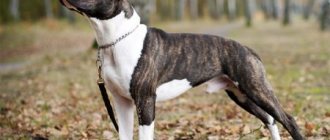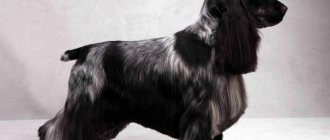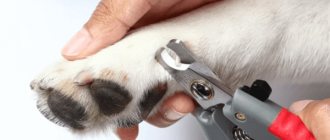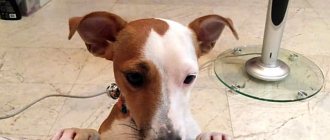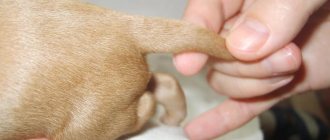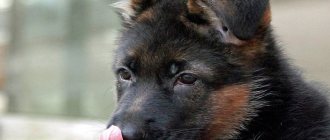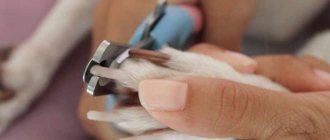The cosmetic procedure of tail docking is now considered blasphemous. Amputation is carried out only to maintain acceptable conformation for exhibitions and breed competitions. But, according to the European Convention for the Protection of Pet Animals, judges are obliged to accept and evaluate equally competitors with a natural tail shape and a docked one.
Read a useful article on the topic: “What is ear cropping in dogs: features and necessity of the procedure.”
History of the procedure
You can’t even imagine how deeply the cupping procedure goes back to ancient times. On ancient Egyptian frescoes you can find an image of a black dog with cropped ears. She personifies the god of the dead, Anubis.
In 450 BC, the first documented case of docking a dog occurred in Ancient Greece. Alcibiades cut off the tail of his dog, which caused a violent reaction from the Athenians.
Lucius Columella wrote that ancient Roman shepherds cut the tails of dogs on the fortieth day of birth to avoid rabies. The ancient Greek traveler Pylos also noticed the docking of Roman dogs.
In 1763, in the German city of Weimar, a decree was issued on the imposition of taxes on peasant dogs. Boyar dogs were docked to distinguish them from peasant dogs.
In the 17th century, in England, all dogs except guard dogs were subject to taxes. To present their dog as a guard dog, people docked their tails.
Why dock your tail and ears?
Hunting breeds have their tails docked to reduce the risk of injury during hunting. For example, Jack Russell Terriers had their organ docked so that, if necessary, they could pull it and pull the dog out of the hole.
In ancient Rome, it was believed that a long tail gave an animal a greater chance of contracting rabies, so they were docked. And the ears of fighting dogs were cut off for more practical reasons. During the earlobe rupture, the animal lost too much blood. Well, if you don’t have ears, no problem. There is an opinion that after ear cropping, fighting dogs are better at picking up sounds.
Why does a dog need a tail?
Oddly enough, tailless dogs do not exist in nature. Animals whose organs have been cropped by humans still try to move them. Why are they doing that?
- Firstly, the tail is a way of communication. By its movements you can determine the mood of the animal. On a subconscious level, people have it in their heads: if a dog wags its tail cheerfully, it means it is friendly, and if it tucks under itself, it means it is scared. But don’t rush to draw conclusions. Dogs can also wave it in other situations.
- Traffic navigator. The organ helps the animal with excessively sudden movements, when moving on an uneven surface, while swimming.
- Method of odor transmission. At its base are the paraanal glands. The individual scent of the animal spreads if it is in an elevated position. When a dog waves its tail, it seems to show everyone its presence. When pressed, he tries to hide.
At what age do they dock?
In the first three days the tail is docked, and in the first 4 months the ears are docked. The tail is a continuation of the spine and consists of 15-23 vertebrae. Therefore, the operation is carried out during the first three days, when the newborn puppy has not yet formed strong bones. This is believed to be the least painful route for the dog.
After 3 days the operation can still be performed, but in this case anesthesia is used. The maximum permissible age for the operation is six months. Later it is very dangerous for the health of the animal.
Tail docking length
Depending on the breed, the tail is docked differently. It is believed that you cannot trim it too much, otherwise the puppy will suffer. Below is the table.
| Breed | Tail length after amputation |
| Boxer | 2-3 vertebrae (to cover the anus) |
| Doberman | 2-3 vertebrae (to cover the anus) |
| Toy Terrier | 2-3 vertebrae (to cover the anus) |
| Rottweiler | 1-2 vertebrae (to cover the anus) |
| Airedale | 1/3 of the previous length |
| Spaniel | 2/5-1/2 the same length |
| Wegner's pointer | 1/2 the same length |
| Kurzhaar | 1/2-3/5 of the previous length |
| Drathaar | 1/3-3/5 of the previous length |
| Poodle | 1/2-2/3 of the previous length |
What breeds of dogs are made
The ear cropping procedure is mandatory for:
- Doberman;
- Pitbull;
- Caucasian Shepherd Dog;
- Alabai.
At the owner's request:
- Staff;
- Cane Corso;
- Boxer;
- Miniature Schnauzer.
The following breeds have their tails trimmed:
- Boxer;
- Poodle;
- Kerry Blue Terrier;
- Rottweiler;
- Yorkshire Terrier;
- Schnauzer;
- Spaniel.
There are a number of breeds that have natural bob tail. This:
- English bulldog;
- Welsh Corgi Pembroke;
- Boston Terrier;
- Australian Shepherd.
Tail docking in an adult dog
If a dog's tail has not been cut within six months of birth, this cannot be done except for medical reasons. Such manipulations can have an extremely negative impact on the health of the animal.
To perform the operation after the 3rd day after birth, anesthesia is used. Adult dogs tolerate it very poorly, even to the point of death. In addition, the operation is very painful and can lead to many complications. So, if you want to dock an animal after six months only for aesthetic reasons, it’s better not to.
Possible complications
Ear cropping most often takes place without any special consequences for the dog’s body: young puppies easily tolerate it, and their tissues heal quite quickly. However, depending on the individual characteristics of the dogs, problems can sometimes arise, and they do not always depend on the quality of the operation - postoperative care has a greater impact on the healing process.
Most often, breeders encounter bleeding - in dogs under 14 weeks of age it occurs much more often than in adult dogs. Not only a fresh postoperative wound can bleed, but also a scar if the integrity of the skin is damaged due to injury.
How does the operation take place?
Tail surgery occurs in two ways:
- The first, and least painful method involves removing the organ with surgical scissors within three days of the puppy’s birth. The operation does not require anesthesia and does not require stitches. Ideally carried out by veterinarians, but can also be carried out by breeders at home.
- The second method is to apply a special rubber band (ligature) to the tip of the tail. The ligature does not allow blood access to the tip, and after a few days it falls off on its own.
Here's how ear cropping works. Here, anesthesia is required for the dog, since the procedure itself is quite painful. You cannot feed the animal 12 hours before surgery. The dog is fixed on the operating table after a dose of novocaine or antipsychotic is administered. Sometimes the operation is performed under general anesthesia. The circumcision process itself occurs using a scalpel. After the cupping procedure, the wound is sutured and treated with antibacterial agents. The duration of the operation generally takes from 30 minutes to 1.5 hours.
Rehabilitation period
After docking the tail, monitor the puppy for several hours to avoid bleeding. Kutya heals quite quickly and without complications.
After ear surgery. To prevent the animal from scratching the seams, a special plastic frame is put on it. If the animal feels pain and constantly rushes about and whines, it is prescribed painkillers. Also spend a lot of time on the seams, they need to be constantly processed. For disinfection, use hydrogen peroxide, brilliant green, calendula tincture or streptocide.
The stitches are removed after a couple of weeks, but the rehabilitation period does not end there. If, after removing the stitches, they have healed correctly, ears will still need to be fitted for the owner and dog.
Possible complications
What a docked tail can theoretically affect:
- communication with animals and socialization. Since this organ is the dog’s means of communication, its removal may affect the perception of it by other animals. Relatives are more aggressive towards bob-tailed dogs, as they do not always correctly perceive their behavior and motives;
- increased aggression. It has been statistically proven that docked dogs are more aggressive than their relatives with healthy tails;
- joint problems. Due to improper distribution of the load on the hind limbs, the animal may develop a hernia in the future. Also, removal of the tail is fraught with the development of deformities of the fingers of the hind limbs;
- motor skills. The tail is not only a way of communication, but also an important regulator of the animal’s movements. Due to its absence, some problems with motor skills arise. Ordinary dogs do not skid as much when turning as docked dogs;
- psyche. Research shows that tail removal, even at an early age, is very painful for the puppy and the shock experienced can lead to mental problems in the future.
Ear cropping is fraught with all sorts of infectious diseases. The dog's ears become open to rainwater, dust and dirt, which can lead to serious illnesses. In addition, if the operation was performed by a non-specialist, the animal’s sutures may not heal properly.
Is it possible to do this yourself
Highly undesirable unless you are a long-time breeder. The procedure is carried out without anesthesia; at this age it is contraindicated. Moreover, no special equipment is required for this. But you shouldn’t do the operation yourself, unless you are an experienced breeder. But the ears are cropped at the age of two to three months under general anesthesia.
Cost and where they make it
Operations are carried out both at home and in specialized veterinary clinics. In Russia, you can dock a puppy’s tail within 500 rubles. But ear cropping, due to the complexity of the procedure, will cost more - in the amount of 2-4 thousand rubles.
In some countries, docking dogs is prohibited. These countries include: Austria, Belgium, Great Britain, Germany, Greece, Denmark, Ireland, Iceland, Spain, Italy, Latvia, Lithuania, Luxembourg, the Netherlands, Norway, Poland, Portugal, Slovenia, Ukraine, Finland, Czech Republic, Switzerland, Sweden , Estonia.
That is, in all EU countries, docking of dogs is unacceptable and is carried out only at home. In the US and some other countries, docking is still acceptable.
Photo gallery
Photo 1. Regular Rottweiler
Photo 2. Rottweiler with amputated tail
Photo 3. Spaniels with a regular tail
Photo 4. Spaniel after docking
Photo 5. Doberman with a tail
Photo 6. Doberman after docking
Veterinarians' opinion
Olga M.:
“As for modern decorative indoor show dogs, docking their ears and tails does not have any serious argument, it is simply ridiculous and absurd.”
Anna P.:
“Remember that a dog’s tail is not skin, but part of the spine! And cutting off the tail means breaking a lot of nerves, which inevitably leads to severe pain and probably phantom pain after surgery."
Postoperative care
The owner must carefully monitor the dryness and cleanliness of the postoperative wound until it heals. Additional treatment is discussed with your veterinarian. Moisturizing ointments inhibit the regeneration process, so they are used only for their intended purpose.
If there are any signs of suppuration, contact your veterinarian immediately. Temporary separation from the mother will also be required. If she persistently licks the puppies' wounds, isolate her in a separate room and bring her to the pups only for feeding.
Pros and cons of cupping
| Pros: | Minuses: |
|
|
As you can see, the minuses with a thick red line cross out all possible pluses. However, whether to dock your pet is up to you to decide!
When docking is necessary due to harm to the dog’s health
It happens that a veterinarian prescribes this operation because it is harmful to the dog’s health. Among the most common causes: tail fractures, cancer, burns or frostbite. Spaniels, which are used during hunting, smell prey and begin to enthusiastically wave their tail, and if it is not docked, there is a possibility of injury. Undocked ends of dog tails can become infected due to microtraumas, which can lead to the risk of tail amputation. But it is not advisable for adult dogs to undergo such an operation.
Briefly about the main thing
- The history of dog docking dates back centuries BC.
- It is a myth that puppies do not experience pain during docking.
- In many countries the procedure is prohibited.
- People's opinions on this matter are very mixed, but veterinarians do not recommend docking.
Have we answered your question fully enough? If not, write your question in the comments below and our specialist will answer it.
Did you like the article? Share it with your friends on social media. networks. This will help them get useful information and support our project.
